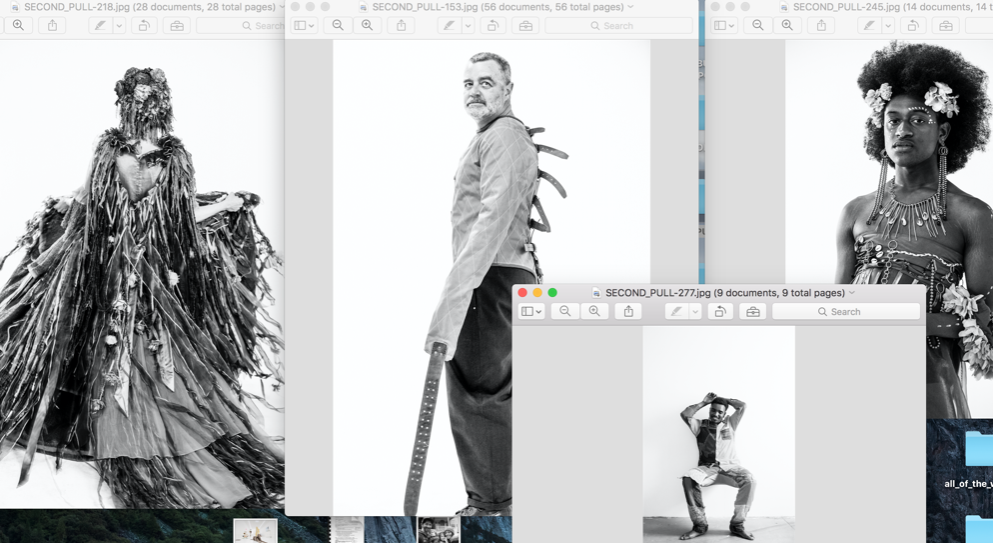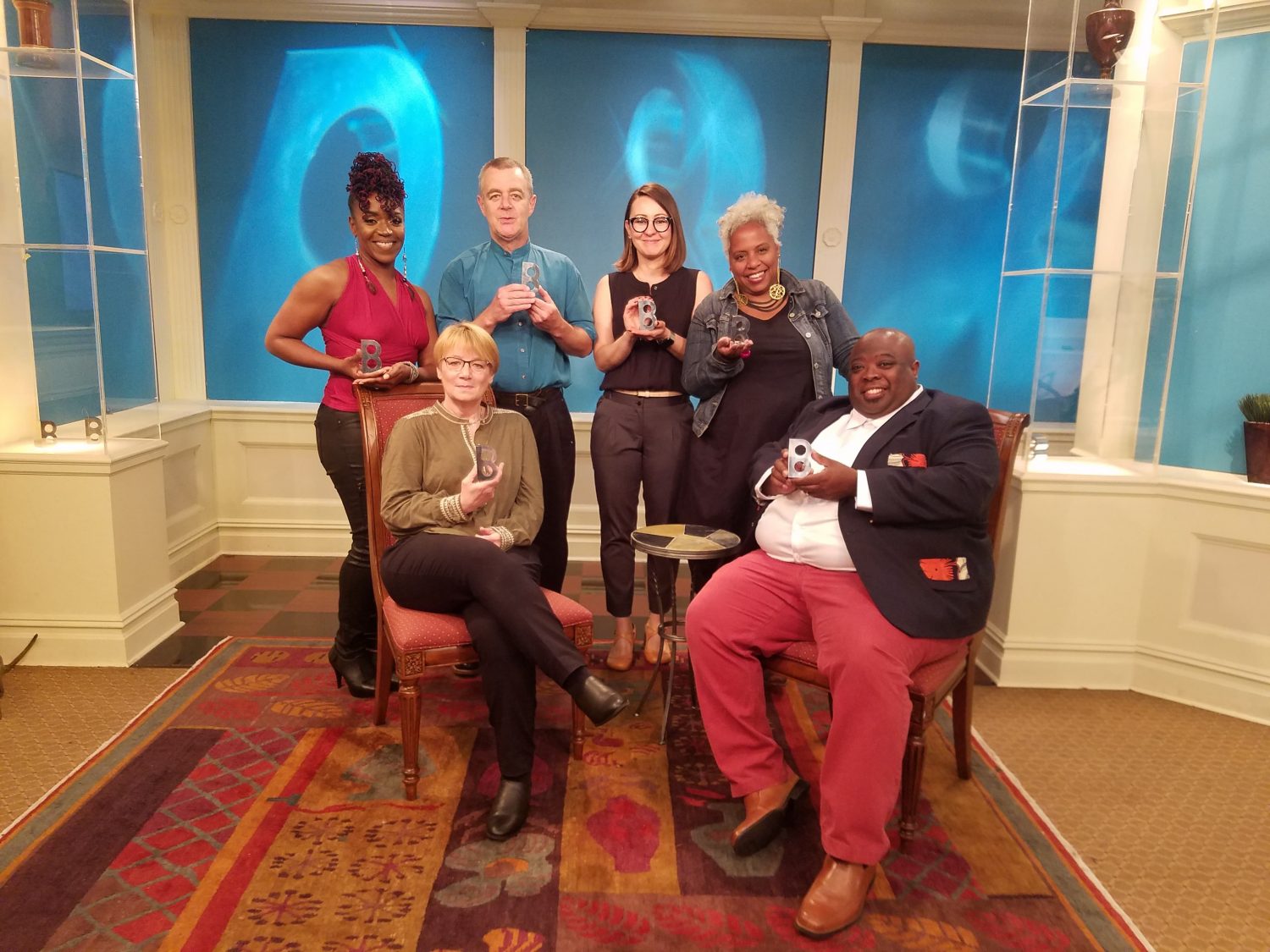This week’s a bit different from past Gallery Roundups in that it represents three shows all at the same location: School 33. Check out Danni O’Brien’s playful sculptures in Tongue Puddles; embrace a multitude of masculinities in Crisis of Connection; and consider the exhibition a work in progress in the Main Gallery’s Studio Resident Biennial. The three shows are up through August 24. For info on School 33 and programming related to these shows, visit their website.
 Cheeny Celebrado-Royer
Cheeny Celebrado-Royer
2019 School 33 Studio Resident Biennial
Typically in curating a show, one would work towards a sense of cohesion. That’s a challenge with this biennial featuring School 33 studio residents whose work may share some affinities or may not, at all. This year’s curator, George Ciscle, took a dedicated and involved approach, thinking of the curatorial process itself as a work in progress with the artists, who were encouraged to experiment, to “take a detour; play; introduce community based and interactive works into their practices.”
What results is a show that pushed the artists to try new things, but asks the visitors to engage more directly with the art and the artists, too. Some of the works on display feel like sketches or small parts of a whole, while for others it’s clear the work will develop throughout the exhibition’s run and beyond. It truly has the energy and feeling of a work in progress—a loud one, at that. Luke Ikard’s deconstructed reclining chair is installed in parts on the wall and on the floor. The metal, moveable component of the reclining foot rest that lies on the floor and a perpetual motor-like soundtrack of snores give a viewer the idea that maybe the whole thing’s inching across the room when you’re not looking, but as it turns out, only the foot rest moves, inflating and deflating on the inhale and the exhale.
Stephanie Williams’ “Lingering Survival of the Unfit” mixes absurdity with tragedy and colonial violence in a stop-motion animation featuring alien-bird-like bodies with sinewy threads that flutter as they march, pause, march again, while a recording of a heavy and candid conversation about the Bataan Death March plays. Meanwhile, in Cheeny Celebrado-Royer’s studio across the way, an oft-shifting installation of cardboard structures and shapes, found objects, tape, and watered-down paint mimics the frantic preparations she and her family made for frequent typhoons in the Philippines. Here, too, the artist shared with me when I visited, are subtler references to colonialism and catastrophe: Architecture in this installation is soft and easily destructible, borders are painted over or simply peeled up, and tiny but ever-present plastic army men hide in plain sight.
We often crave linear paths and easy conclusions—maybe we’re asked to be in a show, so we make a new thing for it, then the new thing goes in the show—but the curatorial focus of this biennial reminds us that art is not about a product. Or, well, maybe it is sometimes, but even so, you’ll likely have to make a few unexpected left turns.

Ian Lewandowski, “After Wojnarowicz,” archival inkjet print (2016)

Darius Johnson, “Darius VII” (2018) & “Love III” (2018)
Crisis of Connection
Over the past few years, many of us—even some men!—have been talking about what toxic masculinity means and why it’s harmful. In many ways those conversations seem too little, too late. The range of harm that toxic masculinity provokes is vast and well-documented: unchecked, it can produce a kind of rage that torches relationships, even kills people. It also hurts men and masculine people themselves in insidious ways, forcing unwritten codes of ethics and behavior and appearances that stifle them holistically. (A good recent read on the subject: Baltimore’s Wil S. Hylton in the New York Times Magazine, analyzing the ways toxic masculinity has opened chasms in his life and almost killed him).
Curator Alexander Jarman sets this small show within this burdensome context, with an emphasis on the inevitable “crisis” of men/masculine people’s struggles to emotionally connect to one another. Most of the eight artists’ work in this show is photographic, and all of it presents men and bodies that implicitly, often via their sexualities or gender expressions, defy a common collective schema of masculinity.
Some of the work on display here is charged and loud as it pulls marginalized bodies toward the center: Lex Reehill’s illustrated coloring book pages invite viewers to appreciate and color in bodies of all shapes, sizes, genders, ethnicities, and abilities; Alexander D’Agostino’s installation with a large sketch-diary/spellbook, pink flogger, and blood-red carnations is like an altar to queer and kinky sex. For much of the show, this defiance is more subtle, even quiet, like Markele Cullins’ 35mm photo of two Black men standing and sitting on rocks, centered but small among a leafy landscape. The men are shirtless and barefoot in trackpants, and seem halfway-posed, as if mid-hike the photographer wanted to hold this moment for a little longer. Darius Johnson’s photo portraits effervesce a subtle tension and a gentle calm: on the left, a person with soft, tired eyes and short twists in their hair, wearing feather earrings and a crushed velvet turtleneck, doesn’t so much confront the viewer as gaze just past us, unfocusing. In the photo on the right, a person has their head cocked to the side, eyes closed and a shoulder bare, in a moment that shares little but suggests a complex interiority and comfort.
Whether an art show—even a striking or challenging one—can widen society’s narrow view of masculine possibilities remains a question. In particular, this show winds up looking like many beautiful, masculine nonbinary and trans and queer people having to shoulder the weight again.
 Danni O’Brien
Danni O’Brien
Tongue Puddles
A large set of lungs suspended midair within this lilac room gave my heart a flutter as I glimpsed it walking up the stairs. The room glows against its surroundings like a screen or a sunny day filtering into a room through a skylight. Like everything else within Danni O’Brien’s installation in School 33’s project space, the lungs are not exactly what I read them as at first—there’s an almost-recognition of shape, scale, and color in that ovoid pair, blanketed by peach and pink hooked yarn, with tubes and artery-like wires spiraling around the edges. Elsewhere, O’Brien’s playful sculptures encourage my free association with kids’ drawings, Dr. Seuss, IKEA’s Småland, a Winnie the Pooh hooked rug project kit my Aunt Cindy gave me that I never finished as a child, and so on.
This surreal but intentional playground is silly and exciting, calling back to the freewheelin’ days of childhood arts and crafts, but with the artist’s more studious eye for pattern, form, and craftsmanship, and an underlying association with the domestic space. The experimental sculptures direct an interesting little dance of logic for a viewer; I’ll assert this peachy, lumpy structure leaning against a wall with a small hooked rug winding in and out of its intestine-like rungs, is a towel rack, rethought—but it’s also really not that, this creature-form with rosettes stuffed into its pipe-like ends.
The hand-wrought textures of these pieces make it seem like beneath the pulpy outer layer lies an armature of bone, capillaries, tissue, and tendons—they feel very much alive, though frozen mid-movement. In the middle of the room a green stalk, like a hat-rack or a headless sunflower whose arms reach out of their own volition, undirected by the sun, is poised on a pink platform whose misshapen three legs provide both necessary and vestigial structural support. A mirror mostly concealed by yogurt-colored yarn blobs and thin, dangly tongues allows my brain’s insistence that that pink platform is a radiator and we’re all just wandering here, inside of a baby brain’s interpretation of a bathroom.
These kinds of associative, childlike logical leaps mirror the artist’s search within colorful abstractions and familiar, domestic-crafty textures. A tall contraption of highlighter-yellow tubing and weightless nylon elements conjures for me some kind of home-exercise gym, of the kind a kid would dream up and, trusting bravely in their design, build out of whatever’s available.
The Friday Gallery Roundup is a curated compilation of three short reviews of three current exhibitions worth your time and consideration. There’s much to see and do in this town every day—check out our calendar and weekly picks for even more options—but here’s a few shows you can check out now.
Photos taken by author.
Featured image, clockwise left to right: installation view of Danni O’Brien’s Tongue Puddles, photos by Darius Johnson, installation view of Cheeny Celebrado-Royer’s studio.






